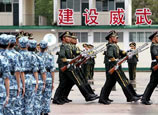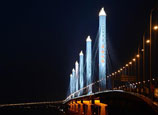
The city of Xi’an is known across the world for its ancient wonder, the terracotta army that guards the tomb of Qin Shi Huang (259-210BC), China’s first emperor.
But Xi’an is also site of many other firsts. It was the site of the first debate over economic policies (81BC), as recorded in the Yan Tie Lun or Discourses on Salt and Iron — and the first national civil servant exam, which was held during the Sui Dynasty (AD581-618).
The city is now making a serious attempt to create another precedent — the first government-built investment zone serving primarily privately owned research-based companies.
“Small technology enterprises are our brand name,” said Chen Hui, deputy director general of the Xi’an High-Tech Zone administrative committee. “That was determined from the very beginning.”
Although started in 1991, the high-tech zone looks different from China’s coastal investment zones. Large manufacturing is not a main feature.
Nor are there many export-oriented simple processing operations. Today those have become largely uncompetitive due to the rising wages of Chinese workers. Many are being relocated to countries where investors can find less expensive laor.
With the exception of the construction site for the massive Samsung production center — an investment project it signed just last year — the zone does not have the multitude of large factory buildings that characterized China’s industrial parks over the past 30 years.
It actually has a shortage of office space, and dormitories and small apartments for its young employees from time to time, said He Kai, vice-director of the Xi’an Software Park Development Center, a main division of the zone.
Most of the 17,000-odd companies operating in the zone are so-called light-asset companies—many in software development and information technology. And when they expand, the biggest constraint they face is the lack of a place to work.
The shortage of office space is made worse when larger application-level research operations are moved in and expanded by global corporations such as GE and Emerson, as well as domestic IT giants Huawei and ZTE.
Huawei’s headquarters is in coastal Shenzhen, one of China’s special economic zones from the 1980s. But in Xi’an it is ready to hire a 10,000-strong research staff.
And ZTE, also based in Shenzhen, is planning a sizeable complex not far from the future Samsung site, the zone's officials reported.
College graduates
Research does not flourish by sheer luck in a landlocked city more than 1,000 kilometers from any seaport. Of all the factors that help the zone grow its enterprise cluster, the first is education. Xi’an boasts the third-largest number of universities of all Chinese cities, following only Beijing and Shanghai.
In terms of privately owned colleges, Xi’an claims the No 1 spot on the Chinese mainland for number of students enrolled.
Local privately owned colleges avidly adjust their curricula to follow trends in the job market. Their graduates may not be able to match counterparts from better-known national universities, but they are good enough in their practical skills to fit the teamwork in small software companies.
Xi’an is also a preferable place to work for professional talent and skilled workers from central and western regions, and even across the country, due to its rich culture, good public infrastructure and more easygoing lifestyle. Adding to the attraction is an admixture of foods adapted from China’s north and south along with Muslim ways of cooking from the west.
John Zhang, president of the New Choice Software Ltd, an outsourcing partner with a US financial service company, is from Hanzhong, a city between Shaanxi and Sichuan provinces.
Zhang Yanchun, vice-general manager of Focus Light Technologies Ltd, a high-power laser company, is from Jilin province in northeastern China.
One particular attraction is the city’s relatively low housing costs. A new flat in Xi’an is priced around 7,000 yuan (about $1,000) a square meter, but in Beijing an apartment can easily cost 30,000 yuan (over $4,500) a square meter, and in Shanghai the price tag can double that.
The result is the turnover rate in Xi’an-based companies at least 10 percentage points lower than in Beijing and Shanghai, said the zone's official Chen.
Transport hub
Xi’an is also one of China’s inland transportation and distribution hubs, crucial to many companies attempting to penetrate the country’s largely untapped vast interior market.
A high-speed rail link with Beijing started operation around New Year’s Day this year, further integrating the city’s business with rest of the country.
Once the gateway to the ancient Eurasian trade route known as the Silk Road, Xi’an is again poised to benefit from links between China and Europe.
Another component driving development is the central government’s intention to promote urbanization and narrow the gap between the more industrial coastal cities and the underdeveloped interior and western frontier regions.
As more incentives are designed in Beijing, only a few cities in those regions have enough human capital and industrial power to benefit from all the policies — Xi’an and Lanzhou are perhaps the only two in northwestern China.
Powered by its investment zones — the zone foremost among them — Xi’an recorded 435 billion yuan ($70 billion) in GDP in 2012. It was the growth champion among all the main cities in China, expanding 12 percent from the year previous at a time when the national economic growth rate finished the year below 8 percent.
A new boost is a central government program to make the nation home to international outsourcing services during its current five year plan period from 2011-15. The high-tech zone’s small software companies are the most likely beneficiaries.
A joint communique released by Ministry of Commerce and the National Development and Reform Commission on Jan 7 said revenue in outsourcing businesses could potentially grow 40 percent annually over the five years and generate more than 4.5 million jobs.
With the Samsung project — priced at $7 billion for phase one alone — and the newly opened high-speed rail link with eastern China, the zone's officials say they see a turning point toward a better blend of investment from the outside and yet to be fully utilized local advantages in Xi’an, first among them its modern army of young software programmers and research workers.
















 2nd cross-sea bridge spanning across Hangzhou Bay to open
2nd cross-sea bridge spanning across Hangzhou Bay to open


![]()
